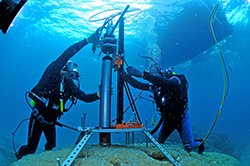Scientists from the Australian Institute of Marine Science (AIMS) and James Cook University have found that that the frequency of large river floods affecting the central Great Barrier Reef (GBR) has increased since the late 19th century.
In a peer-reviewed article published recently in the journal, Coral Reefs, the researchers discuss how this change coincided with a climate shift in the tropical Pacific and surprised earlier European settlers of northeast Queensland. Townships of Wickham at the mouth of the Burdekin River and Dalrymple 300 km upstream were devastated by major floods in 1864 and 1870. Coral records reveal that these were in the top ten per cent of extreme high flows since 1648 and that the 1870, 1974, 1991 and the recent 2011 floods were the four largest floods in the past 364 years.
“Our studies show that flooding is now occurring every six years, compared to every 20 years before European settlement,” said AIMS scientist, Dr Janice Lough.
The team have been studying luminescence in slices of coral cores from the central GBR, directly in the path of Burdekin River flood plumes. The luminescent lines are revealed when the corals are illuminated by ultra-violet light – a phenomenon first discovered by AIMS’ scientists in the 1980s. Newly collected cores allow us to update the long record through the 2011 floods that affected large parts of Queensland.
“The climate records captured in annually-banded coral skeletons, similar to tree rings, provide an unbiased history of changing environmental conditions both on land and affecting the reef and allows us to place recent changes in a much longer term context.” she said.
Data from this study revealed that:
- High flow events are occurring every six years (1948-2011), compared to every 20 years (1748-1847), and
- Three of the most extreme flood events have occurred within the past 40 years (1974, 1991, and 2011).
Extreme flood events cause considerable disruption on land and also can have sizeable impacts on sensitive marine ecosystems such as inshore coral reefs and seagrass meadows. The low salinity flood waters carry sediment and pollutants out to the reef which have been implicated in freshwater coral bleaching, slowing coral growth, smothering of seagrass meadows and crown-of-thorn starfish outbreaks. The evidence from coral cores of more frequent extreme flood events (an expected consequence of a rapidly warming world) has significant consequences for the future health of the GBR.
Researchers from James Cook University worked in collaboration with AIMS scientists on the study.
Freshwater impacts in the central Great Barrier Reef: 1648-2011 is published in Coral Reefs, the Journal of the International Society for Reef Studies and can be viewed at:
Authors: Lough JM, SE Lewis and NE Cantin.


